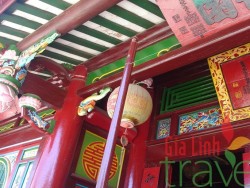Hoi An
Hoi An’s Buildings


Hoi An

Hoi An
Hoi an’s architectural improvement handed via three stages. The first was early interval as an insignificant village of bamboo shacks, of which none remain.
The second interval was some time after it expanded into to develop into a flourishing commercial port attracting merchant ships from afar. From the center of the seventeenth century, the rising Chinese and Japanese communities started erecting places of worship, meeting halls and, later, residential houses.
The primary of these were Chinese assembly halls that also served as temples for ancestor worship, adopted by pagodas devoted to the worship of Taoist gods, Confucius and Buddha. As the town turned more affluent and populous, further meeting halls and pagodas were built together with nice houses for merchants who had turn into full-time residents servicing an increasing volume of exports and imports.
All have been built predominantly of wooden on a stone foundation. Those who survive are the architectural heritage that justified its World Heritage listing and are the primary attraction for the hundreds of 1000’s of visitors that arrive every year.
The architectural styles are primarily based upon that of China and Japan; however there are additionally Vietnamese options and a few influences from Europe and different countries that frequented the port.
As the port declined throughout and the number of traders dwindled during the late 18th century, a number of the buildings fell into disrepair and collapsed. The gaps have been in-stuffed by unattractive rendered brick buildings constructed in the boxy Vietnamese style.
The primary architectural points of interest
There’s a good municipal museum in the Ancient Town that is worth a go to, not solely in its own right, but additionally as a resource of informative guide books at varying prices and levels of detail. The following is a short record of probably the most distinctive of the town’s many elderly buildings.
The Japanese Bridge
Essentially the most well-known is popularly often known as the Japanese Covered Bridge. Unfortunately, the name leads most guests to overlook the small pagoda of which it is an integral element. Indeed, it’s debatable whether it was of Japanese development at all. Nevertheless, it’s a sexy construction and is probably enhanced by the mystery surrounding its origins.
The Assembly Halls
Tran Phu, one of the major streets, has five interesting meeting halls all on the left hand side with your again to the bridge. Four are for particular ethnic teams in China; however the Chinese language Assembly Hall is open to all Chinese seafarers. From the bridge, the Cantonese Meeting Hall is the first you come to, adopted by the Chinese language, Fukien, Hainan and, somewhat additional, the Chaozhou Assembly Halls. All mix social and welfare capabilities as well as places for ritual and worship. Each has distinctive features usually referring to the ocean, sailors and shipwrecks.
The Retailers’ Houses
The various Merchants’ Houses are scattered around the town. Usually, they are a melangé of Vietnamese, Chinese and Japanese structure, every with distinguishing options and styles of inside decoration. Many mixed commercial and residential capabilities – a storage and trading area within the entrance, and accommodation at the rear. They have been normally long and slim, with one or two interior open courtyards, sometimes with decorative pools, offering gentle and recent air.
Many also contained non-public temples, either integrated into the construction or in a separate building, and family tombs.
Larger houses had intensive lofts, additionally on the entrance and used as warehouses. A couple of comparable constructions might be present in Hanoi’s Old Quarter. Aside from that, the structure of Hoi A’s outdated houses is a singular instance of a blend of many cultural styles.
Pagodas
There are also several pagodas in Hoi An. One of many oldest is the Ong Hoi an, dating back to aminimum of 1653. Inside, a huge red-confronted effigy of Basic Quan Cong dominates the array of statues and votive objects.
Believed to be the primary pagoda in Hoi an, the Chuc Thanh was really inbuilt 1744, not in thirteenth century as described in most guide books. The confusion has been traced to an error by a protracted-lifeless artisan who carved the Chinese language Emperor’s identify wrongly on the roof beam, thus finding him in a much earlier dynasty. Nevertheless, it’s properly worth a visit.
Among the other pagodas and temples, you’ll find a small Cao Dai temple tucked away. Comparatively modern, it is an outpost of Vietnam’s ‘tailored faith’ based within the south.
Each the Truong and the Tran family chapels are interesting. Each was built by ethnic Chinese folks, and reflects the architectural styles of each China and Japan. The altar in the Tran chapel has a set of hand carved stone tablets commemorating the ancestors. The rear garden is a delight in miniature.
Museums
Aside from the municipal museum, housed in an unprepossessing brick construction, a number of the outdated buildings have been transformed into museums. The Museum of History and Culture is housed in a redundant pagoda, and gives a good overview of the city’s development. The Museum of Trade Ceramics, funded by donations from Japan, is more specialized. It has some fascinating displays of ceramics and porcelain, one of many mainstays of Hoi and’s buying and selling past and some detailed architectural drawings.
